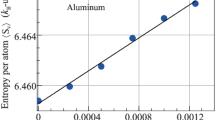Abstract
A thermodynamics-based description, in the form of an extended phase diagram, of melting and solid-state amorphization is proposed which brings out the parallels between these two phenomena and suggests that their underlying causes are apparently the same. Through molecular dynamics simulations we demonstrate that every crystal, in principle, can undergo two different types of melting transitions with characteristic features that are also observed in radiation- and hydrogenation-induced amorphization experiments on ordered alloys. The first type, defined in terms of free energies, is shown to involve the heterogeneous nucleation of the liquid or amorphous phase at extended lattice defects (such as grain boundaries, free surfaces, voids, or dislocations) and subsequent thermally-activated propagation of solid-liquid/amorphous interfaces through the crystal. The second type, arising from a mechanical instability limit described by Born, is homogeneous and does not require thermally-activated atom mobility. It is suggested that the role of chemical and structural disordering, a prerequisite for irradiation- but not hydrogenation-induced solid-state amorphization, is merely to drive the crystal lattice to a critical combination of volume and temperature at which the amorphous phase can form either heterogeneously or homogeneously.
Similar content being viewed by others
References
J. Bloch, J. Nucl. Mater. 6, 203 (1962).
For recent reviews, see W. L. Johnson, Prog. Mater. Sci. 30, 81 (1986); Solid-State Amorphizing Transformations, edited by R. B. Schwartz and W. L. Johnson (Elsevier Sequoia, The Netherlands, 1988); J. Less-Common Met. 140 (1988).
R.W. Cahn and W. L. Johnson, J. Mater. Res. 1, 724 (1986).
P. Richet, Nature 331, 56 (1988).
H. J. Fecht and W. L. Johnson, Nature 334, 50 (1989).
P.R. Okamoto, L.E. Rehn, J. Pearson, R. Bhadra, and M. Grimsditch, J. Less-Common Met. 140, 231 (1988).
J. L. Tallon, Phil. Mag. 39, 151 (1979); J. L. Tallon and W. H. Robinson, Phil. Mag. 36, 741 (1977); J. L. Tallon, J. Phys. Chem. Solids 41, 837 (1984).
R. L. Cormia, J. D. Mackenzie, and D. Turnbull, J. Appl. Phys. 34, 2239 (1963).
J. Daeges, H. Gleiter, and J. H. Perepezko, Phys. Lett. A119, 79 (1986); R. W. Cahn, Nature 323, 668 (1986).
R. M. J. Cotterill, J. Cryst. Growth 48, 582 (1980).
S. R. Phillpot, J. F. Lutsko, D. Wolf, and S. Yip, Phys. Rev. B 40, 2831 (1989).
M. Born and K. Huang, Dynamical Theory of Crystal Lattices (Oxford, 1962).
H. Mori, H. Fujita, M. Tendo, and M. Fujita, Scripta Metall. 18, 783 (1984); D. E. Luzzi and M. Meshii, Res. Mechanica 21, 207 (1987).
H. Mori and H. Fujita, Proc. Yamada Conf. VII on “Dislocations in Solids”, edited by H. Suzuki (Univ. of Tokyo, 1985), p. 563.
W. J. Meng, P. R. Okamoto, L. J. Thompson, B. J. Kestel, and L. E. Rehn, Appl. Phys. Lett. 53, 1820 (1988); W. J. Meng, P. R. Okamoto, and L. E. Rehn, Proc. ASM Symp. on “Science of Advanced Materials”, edited by H. Wiedersich and M. Meshii, Chicago, Sept. 1989 (to be published).
A. R. Ubbelohde, Molten State of Matter: Melting and Crystal Structure (Wiley, Chichester, 1978).
L. L. Boyer, Phase Transitions 5, 1 (1985).
R.W. Cahn, Nature 273, 491 (1978).
R.W. Cahn, Nature 323, 668 (1986).
N. G. Ainslie, J. D. Mackenzie, and D. Turnbull, J. Phys. Chem. 65, 1718 (1961).
P. Buffat and U-P. Borel, Phys. Rev. A 13, 2287 (1976).
J. B. Boyce and M. Stutzmann, Phys. Rev. Lett. 54, 562 (1985).
C. J. Rossouw and S. E. Donnelly, Phys. Rev. Lett. 55, 2960 (1985).
F. F. Abraham, Adv. Phys. 35, 1 (1986).
J. F. Lutsko, D. Wolf, S. R. Phillpot, and S. Yip, Phys. Rev. B 40, 2841 (1989).
M. S. Daw and M. I. Baskes, Phys. Rev. Lett. 50, 1285 (1983); Phys. Rev. B 29, 6443 (1984).
S. M. Foiles, Phys. Rev. B 32, 7685 (1985).
J. F. Lutsko, D. Wolf, S. Yip, S. R. Phillpot, and T. Nguyen, Phys. Rev. B 38, 11572 (1988).
D. Wolf, J. de Phys. Colloq. C4 46, Cr-197 (1985).
J. Frenkel, Phys. Z. Sowjetunion 1, 498 (1932).
J. Q. Broughton, G. H. Gilmer, and K. A. Jackson, Phys. Rev. Lett. 49, 1496 (1982).
M. Parrinello and A. Rahman, J. Appl. Phys. 52, 7182 (1981).
J. Ray and A. Rahman, J. Chem. Phys. 80, 4423 (1984); Phys. Rev. B 32, 733 (1985).
D. E. Luzzi, H. Mori, H. Fujita, and M. Meshii, Scripta Metall. 19, 897 (1985).
H. Fujita, H. Mori, and M. Fujita, Proc. 7th Int. Conf. on “High-Voltage Electron Microscopy”, Berkeley, edited by R. M. Fisher, R. Gronsky, and K. H. Westmacott, 233 (1984).
X. L. Yeh, K. Samwer, and W. L. Johnson, Appl. Phys. Lett. 42, 242 (1983).
R. B. Schwartz and R. R. Petrich, J. Less-Common Met. 140, 171 (1988).
A. Seidel, G. Linker, and O. Meyer, J. Less-Common Met. 145, 189 (1988).
C. Massobrio, V. Pontikis, and G. Martin, Phys. Rev. Lett. 62, 1142 (1989).
J. Koike, P. R. Okamoto, L. E. Rehn, R. Bhadra, M. Grimsditch, and M. Meshii, MRS Symp. Proc. (to be published).
E. Kröner, J. Eng. Mech. Div. 106, 890 (1980).
T. Egami and Y. Waseda, J. Non-Cryst. Solids 64, 113 (1984).
C. S. Nichols and D. Clarke, MRS Symp. Proc. (to be published).
O. Mishima, L. D. Calvert, and E. Whalley, Nature 310, 3935 (1984).
D. N. Seidman, R. S. Averback, P. R. Okamoto, and A. C. Bailey, MRS Symp. Proc. 51, 349 (1987).
V. Vook, Phys. Rev. 125, 855 (1962).
S. Andersson, Phys. Lett. 33A, 455 (1970).
For a recent review, see P. Ehrhart, K. H. Robrock, and H. Schober, in Physics of Radiation Effects in Crystals, edited by R. A. Johnson and A. N. Orlov (Elsevier, North-Holland, Amsterdam, 1986), pp. 7–106.
Author information
Authors and Affiliations
Rights and permissions
About this article
Cite this article
Wolf, D., Okamoto, P.R., Yip, S. et al. Thermodynamic parallels between solid-state amorphization and melting. Journal of Materials Research 5, 286–301 (1990). https://doi.org/10.1557/JMR.1990.0286
Received:
Accepted:
Published:
Issue Date:
DOI: https://doi.org/10.1557/JMR.1990.0286



